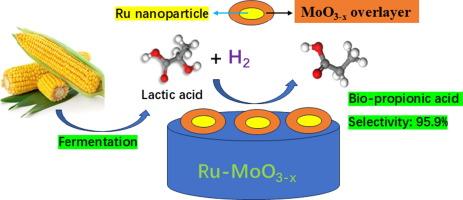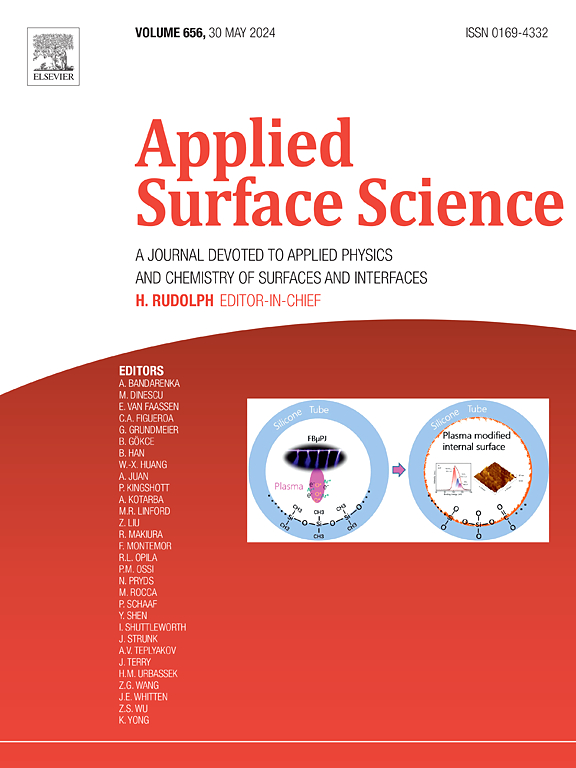通过 Ru 稳定的 MoO3-x 叠层改变乳酸氢化的区域选择性
IF 6.3
2区 材料科学
Q2 CHEMISTRY, PHYSICAL
引用次数: 0
摘要
由于生物乳酸分子含有羟基(-OH)和羧基(-COOH)等活性双官能团,因此控制乳酸转化的区域选择性是生产生物基化学品的关键。在此,我们报告了具有丰富氧空位的 Ru 稳定 MoO3-x 覆盖层通过 C-OH 加氢脱氧反应颠覆了乳酸氢化到丙酸(PA)的区域选择性,实现了高达 95.9% 的 PA 选择性,这与 Ru 粒子表面通过氢化 -COOH 主导 1,2 丙二醇选择性的催化特征完全不同。此外,封装氧化物层的活性还可扩展到其他羟基酸,如乙醇酸、3-羟基丙酸和 DL-2- 羟基丁酸,生成相应的羧酸,显示出独特的 -OH 基团氢脱氧能力。在还原气氛(如 H2-Ar 混合气)下,可动态生成富含氧空位的封装氧化层,并由纳米 Ru 颗粒有效稳定,从而赋予 Ru-MoO3-x 比 MoO3、MoO3-x 和 Ru-MoO3 更优越的活性。令人欣慰的是,在 Ru 稳定的 MoO3-x 覆层的作用下,乳酸转化率和丙酸选择性在运行 5 个周期后几乎没有下降。这项工作为构建具有丰富氧空位的缺陷封装氧化物层提供了一种有效的策略,有助于从生物乳酸中生产出所需的生物基聚酰胺化学品。本文章由计算机程序翻译,如有差异,请以英文原文为准。

Overturning lactic acid hydrogenation regioselectivity via Ru-stabilized MoO3-x overlayers
Controlling regioselectivity in lactic acid conversion is a key for production of bio-based chemicals due to bio-lactic acid molecule containing active bifunctional groups such as hydroxyl (–OH) and carboxyl (–COOH). Here, we report that the Ru-stabilized MoO3-x overlayers with rich oxygen vacancies overturn lactic acid hydrogenation regioselectivity to propionic acid (PA) via C-OH hydrodeoxygenation, achieving a high PA selectivity of 95.9%, which is completely different from the catalytic feature of the Ru particle surfaces with dominating 1,2-propanediol selectivity through hydrogenation of –COOH. Furthermore, the activity on the encapsulating oxide layers can be extended to other hydroxy acids such as glycolic acid, 3-hydroxypropionic acid, and DL-2-hydroxybutylic acid to generate their corresponding carboxylic acids, displaying a unique ability for hydrodeoxygenation of –OH group. The encapsulating oxide layers with rich oxygen vacancies can be dynamically generated in the presence of the reductive atmosphere such as H2-Ar mixture, and efficiently stabilized by Ru nanoparticles, thus endowing more excellent activity of Ru-MoO3-x than that of MoO3, MoO3-x and Ru-MoO3. Encouragingly, lactic acid conversion and propionic acid selectivity have hardly decayed during running 5 cycles due to Ru-stabilized MoO3-x overlayers. This work provides an efficient strategy for constructing the defective encapsulation oxide layers with rich oxygen vacancies, which helps to produce the desired bio-based chemical of PA from bio-lactic acid.
求助全文
通过发布文献求助,成功后即可免费获取论文全文。
去求助
来源期刊

Applied Surface Science
工程技术-材料科学:膜
CiteScore
12.50
自引率
7.50%
发文量
3393
审稿时长
67 days
期刊介绍:
Applied Surface Science covers topics contributing to a better understanding of surfaces, interfaces, nanostructures and their applications. The journal is concerned with scientific research on the atomic and molecular level of material properties determined with specific surface analytical techniques and/or computational methods, as well as the processing of such structures.
 求助内容:
求助内容: 应助结果提醒方式:
应助结果提醒方式:


